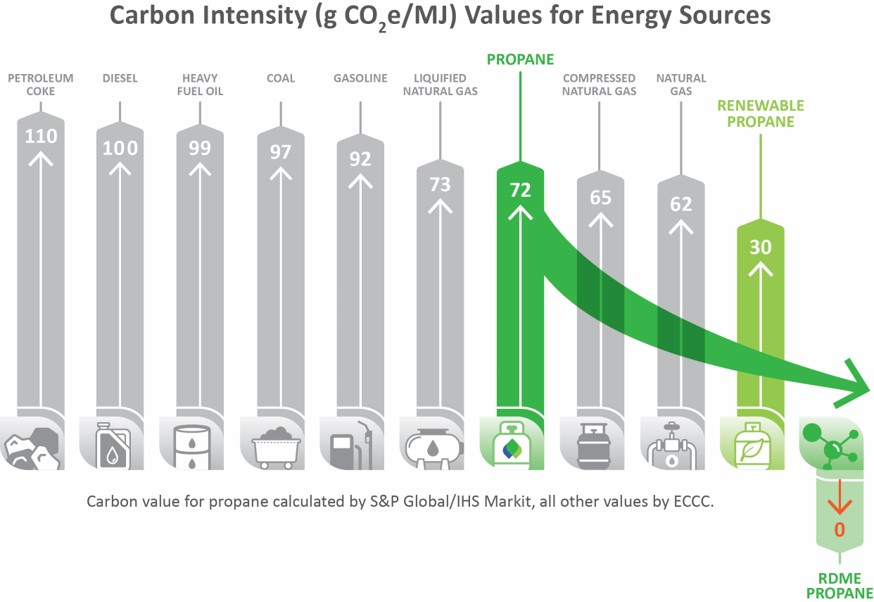The Journey To Net-Zero
How to Reduce Emissions Now
In the race towards achieving net-zero emissions by 2050, businesses need solutions that will help them take incremental steps towards that final goal, utilizing readily available lower-carbon fuels for a rapid yet realistic transition. Propane, as an example, is a low-emission fuel that is readily available and doesn’t require new technology, infrastructure or capital investment to significantly reduce a company’s carbon footprint. Think of propane as a bridge fuel that allows businesses to displace carbon-intensive fuels and can be implemented today throughout business operations and in various applications. Superior Propane works with industry to implement a measured approach to steadily "turn the dial" towards net-zero emissions as opposed to trying to "flip the switch" which isn’t always a realistic or feasible option.
Propane as the Bridge Fuel to Zero Emissions
Propane deserves more recognition for the important role it plays in lowering emissions, especially in areas where the infrastructure for renewables is still developing or where intermittent energy sources may not suffice. The advantages of propane are significant: it burns cleaner and, according to the Canadian Propane Association, generates 60% fewer greenhouse gas emissions than gasoline, 38% fewer emissions than diesel, and 30% fewer emissions than home heating oil over its lifecycle. Not only does propane help mitigate climate change and decarbonization, it’s also easy to incorporate into business operations for various applications including building heat, forklifts, generators, agricultural equipment, auto propane for fleets, and more.
Propane serves as an efficient and clean fuel in homes, businesses, farms, and fleets, making it an excellent choice for immediate transition. Plus, propane can be stored conveniently in tanks without degradation, and can be quickly mobilized to rural and remote areas. Being non-toxic, propane carries minimal risk of harmful spills. In combination with a well-established distribution network, propane ensures widespread availability and significantly contributes in areas where renewable infrastructure may be intermittent or not feasible.
The Dial Approach to Energy Transition
The shift to a net-zero carbon future is crucial, but it's not something that can be achieved overnight. The transition takes time, resources, infrastructure and big capital investment. Not to mention the reliability of energy supply and widespread accessibility are other significant barriers to overcome. Companies can’t just flip a switch, but they can turn the dial quickly to achieve corporate net-zero strategies in a more realistic way. They can “dial up” environmental performance and meet targets by progressively replacing carbon-intensive fuels with cleaner alternatives like propane.
Think of a dial from 1 to 10, where 10 represents the ultimate net-zero target. Each notch is an evolution in the energy transformation and getting there is a gradual process using currently available energy solutions. This approach allows for continuous improvement, phased implementation, and risk mitigation. It is feasible in all communities and industries, including those in remote regions, and provides practical solutions that are available and ready to be adopted today.
At the 2023 Global Energy Show, Superior Propane President Rick Carron took the stage to discuss the importance of bridge-fuels and the strategies that companies can adopt to successfully integrate low-carbon energy alternatives into their operations. "We work closely with businesses to dial up their energy performance, where each notch on the dial represents an evolution towards a net-zero future,” says Carron. “Together we develop customized strategies that integrate cleaner alternatives like propane, ensuring a steady and practical pace towards achieving their environmental goals."
The Importance of a Diversified Energy Portfolio
While electrification is often seen as the primary solution to address emissions, it is important to recognize that there is no silver bullet. The transition to net-zero must be affordable and it must account for the complete lifecycle of an energy source. Energy choice will allow for affordable, low emission options.
A comprehensive approach that combines multiple energy solutions is necessary. By integrating cleaner alternatives like propane alongside electrification efforts, businesses can achieve a more resilient and balanced approach to reducing emissions. This diversified energy mix ensures that challenges associated with intermittent renewables and infrastructure limitations are addressed, while also providing practical and readily available solutions for businesses to reduce their carbon footprint.
Propane in Action: Real-world Examples
Propane is already helping businesses around the world turn the dial towards net-zero. For instance, propane is replacing diesel and reducing emissions in power generation, fleet vehicles, and numerous other applications due to its reliability and high performance in cold climates.
One of Superior’s large commercial customers located in BC, has been able to reduce emissions by 15% by switching from diesel to propane, saving over 21% per year in fuel costs and reducing equipment maintenance frequency which lowers their overall operational costs.
Similarly, Pacific Western Transport, which operates Canada's largest propane-fueled school buses fleet, cut emissions by 44% and saved $3 million per year in fuel costs by switching to Superior Propane.
Looking Ahead: Propane and the Future of Renewable Energy
Propane can complement solar and wind power through a co-fuel strategy. In situations where renewable energy sources such as solar and wind are intermittent, propane can act as a reliable backup energy source, ensuring consistent and uninterrupted power.
Furthermore, propane's adaptability extends to blending with other substances to reduce emissions. Blends like DME offer a cleaner-burning power source for applications such as transportation, heating, and cooking. These innovative propane blends provide opportunities for decarbonizing sectors traditionally reliant on fossil fuels, contributing to a greener future.
Turning the Dial towards Net-Zero
While the journey towards net-zero emissions is challenging, incorporating propane as part of the energy transition offers an accessible, immediate and effective method to start 'turning the dial' today. It reduces greenhouse gas emissions, provides a reliable energy source, and plays nicely with other fuels and renewables.
With Superior Propane as a trusted partner, businesses can confidently navigate the complexity of the energy transition. Our expertise, established partnerships, and commitment to a lower-carbon future position us to help businesses and communities turn the dial at a steady and practical pace to successfully achieve targets.
As we look to the future, it is vital that policymakers recognize the crucial role of low-carbon fuels like propane in the journey towards sustainability. By legislating and advocating for a dial approach, we can ensure a smooth, manageable, and successful transition to a net-zero future.
Contact Canada's Leading Propane Supplier

OR
Call Us Now at
1-855-965-4855



